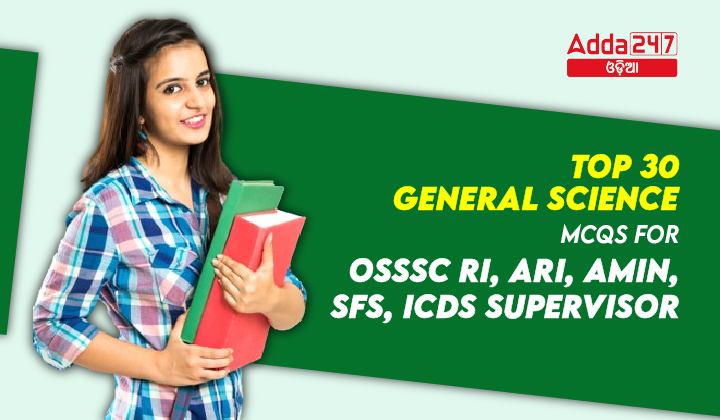General Science forms an essential part of many competitive exams in India, including those conducted by the Odisha Sub-ordinate Staff Selection Commission (OSSSC) for various positions like Revenue Inspector (RI), Assistant Revenue Inspector (ARI), Amin, SFS, and ICDS Supervisor. To excel in these exams, candidates must have a strong grasp of fundamental scientific concepts. Here, we present the top 30 General Science multiple-choice questions (MCQs) to help candidates prepare effectively.
Top 30 General Science MCQS For OSSSC RI,ARI, Amin, SFS, ICDS Supervisor 14 March 2024
- A person who is pulling a bucket filled with water falls behind with the sudden break of the rope. Which of the following laws of Newton comes into action?
[A] First Law
[B] Second law
[C] Third law
[D] First and third lawCorrect Answer: C [Third law]
Notes: Newton’s third law states that for every action, there is an equal and opposite reaction. The person falling behind due to the sudden break of the rope exemplifies this law as their backward movement is a reaction to the force exerted by the breakage of the rope. - Who among the following is credited to work for the unification of electricity, magnetism, and optics field of Physics?
[A] James Clerk Maxwell
[B] Michael Faraday
[C] Haris Christian Oersted
[D] Isaac NewtonCorrect Answer: A [James Clerk Maxwell]
Notes: James Clerk Maxwell is credited for his efforts in unifying the fields of electricity, magnetism, and optics. His mathematical work on electromagnetism led to the realization that light is an electromagnetic wave. - Who among the following is credited for the Corpuscular theory of light?
[A] Isaac Newton
[B] Christiaan Huygens
[C] Albert Einstein
[D] James Clerk MaxwellCorrect Answer: A [Isaac Newton]
Notes: Isaac Newton proposed the Corpuscular theory of light, which posited that light consists of small particles or “corpuscles.” However, this theory was later replaced by Huygens’ wave theory due to its inability to explain various phenomena such as diffraction and interference. - Which law of thermodynamics states that energy cannot be created or destroyed, only transformed from one form to another?
[A] First Law
[B] Second Law
[C] Third Law
[D] Zeroth LawCorrect Answer: A [First Law]
Notes: The First Law of Thermodynamics, also known as the Law of Conservation of Energy, states that energy cannot be created or destroyed, only transformed from one form to another. - The rate of change of momentum of an object is directly proportional to the net force acting on it. This statement is a representation of which law of motion?
[A] First Law
[B] Second Law
[C] Third Law
[D] Fourth LawCorrect Answer: B [Second Law]
Notes: Newton’s Second Law of Motion states that the rate of change of momentum of an object is directly proportional to the net force acting on it, and this change in momentum occurs in the direction of the applied force. - When a balloon filled with helium gas is released, it moves upwards due to which principle?
[A] Archimedes’ Principle
[B] Bernoulli’s Principle
[C] Pascal’s Principle
[D] Boyle’s LawCorrect Answer: A [Archimedes’ Principle]
Notes: Archimedes’ Principle states that an object immersed in a fluid experiences an upward buoyant force equal to the weight of the fluid displaced by the object. In the case of a helium-filled balloon, it experiences an upward buoyant force greater than its weight, causing it to rise. - Which scientist is credited with the discovery of the neutron?
[A] Ernest Rutherford
[B] James Chadwick
[C] Niels Bohr
[D] J.J. ThomsonCorrect Answer: B [James Chadwick]
Notes: James Chadwick is credited with the discovery of the neutron in 1932 through his experiments with beryllium and paraffin wax. This discovery played a significant role in advancing the understanding of atomic structure and nuclear physics. - What is the range of masses involved in the study of Physics?
[A] 10^-19 kg to 10^38 kg
[B] 10^-30 kg to 10^55 kg
[C] 10^-30 kg to 10^30 kg
[D] 10^-19 kg to 10^55 kgCorrect Answer: B [10^-30 kg to 10^55 kg]
Notes: The range of masses in Physics spans from 10^-30 kg, the mass of an electron, to 10^55 kg, the mass of the known observable universe. - Power of a lens is measured in which of the following units?
[A] metre
[B] dioptre
[C] lumen
[D] wattCorrect Answer: B [dioptre]
Notes: The power of a lens, denoted in dioptre (D), measures its ability to bend light, calculated as the reciprocal of its focal length. - Which scientist formulated the theory of relativity?
[A] Isaac Newton
[B] Albert Einstein
[C] Galileo Galilei
[D] Max PlanckCorrect Answer: B [Albert Einstein]
Notes: Albert Einstein formulated the theory of relativity, which revolutionized the understanding of space, time, and gravity in physics. - What is the SI unit of electric charge?
[A] Ampere
[B] Coulomb
[C] Volt
[D] OhmCorrect Answer: B [Coulomb]
Notes: The Coulomb (C) is the SI unit of electric charge, named after the French physicist Charles-Augustin de Coulomb. - Which of the following is a fundamental force of nature responsible for the interactions between particles in an atom’s nucleus?
[A] Gravity
[B] Electromagnetic force
[C] Weak nuclear force
[D] Strong nuclear forceCorrect Answer: D [Strong nuclear force]
Notes: The strong nuclear force is one of the four fundamental forces of nature, responsible for binding protons and neutrons together in an atomic nucleus. - What is the SI unit of pressure?
[A] Pascal
[B] Newton
[C] Joule
[D] WattCorrect Answer: A [Pascal]
Notes: The SI unit of pressure is the Pascal (Pa), named after the French mathematician and physicist Blaise Pascal. - What is the acceleration due to gravity on the surface of the Earth?
[A] 9.8 m/s^2
[B] 6.67 × 10^-11 Nm^2/kg^2
[C] 3.00 × 10^8 m/s
[D] 1.6 m/s^2Correct Answer: A [9.8 m/s^2]
Notes: The acceleration due to gravity on the surface of the Earth is approximately 9.8 m/s^2. - What is the SI unit of electric current?
[A] Ampere
[B] Volt
[C] Coulomb
[D] OhmCorrect Answer: A [Ampere]
Notes: The SI unit of electric current is the Ampere (A), named after the French physicist André-Marie Ampère. - Which of the following devices is used to measure electric current?
[A] Voltmeter
[B] Ammeter
[C] Ohmmeter
[D] GalvanometerCorrect Answer: B [Ammeter]
Notes: An ammeter is a device used to measure electric current in a circuit. - What is the formula for calculating work done by a force?
[A] Work = Force × Time
[B] Work = Force × Distance
[C] Work = Mass × Acceleration
[D] Work = Energy × TimeCorrect Answer: B [Work = Force × Distance]
Notes: The work done by a force is calculated by multiplying the force applied by the distance over which the force is applied. - Which of the following statements about the acceleration due to gravity is correct?
[A] The acceleration due to gravity is same at the equator and the poles.
[B] The acceleration due to gravity is maximum at the poles.
[C] The acceleration due to gravity is least at the poles.
[D] None of the above.Correct Answer: B [The acceleration due to gravity is maximum at the poles.]
Notes: The acceleration due to gravity is strongest at the poles and weakest at the equator. As we move from the equator towards the poles, the value of acceleration due to gravity increases. - What happens to the orbital velocity of a satellite when the radius of orbit is increased?
[A] It decreases.
[B] It increases.
[C] It remains the same.
[D] None of the above.Correct Answer: A [It decreases.]
Notes: When the radius of the orbit of a satellite is increased, its orbital velocity decreases. This relationship is governed by the laws of orbital mechanics. - Which of the following is the SI unit of frequency?
[A] Hertz
[B] Newton
[C] Watt
[D] PascalCorrect Answer: A [Hertz]
Notes: The SI unit of frequency is the Hertz (Hz), which represents the number of cycles per second. - In which part of an atom are the protons and neutrons located?
[A] Nucleus
[B] Electron cloud
[C] Electron shell
[D] Valence shellCorrect Answer: A [Nucleus]
Notes: Protons and neutrons are located in the nucleus of an atom, while electrons occupy the electron cloud surrounding the nucleus. - What is the process by which a solid changes directly into a gas without passing through the liquid state called?
[A] Evaporation
[B] Sublimation
[C] Condensation
[D] MeltingCorrect Answer: B [Sublimation]
Notes: Sublimation is the process by which a solid changes directly into a gas without passing through the liquid state. Examples include dry ice (solid carbon dioxide) subliming into carbon dioxide gas. - A group of plants and animals with similar traits of any rank is
[A] Taxon
[B] Species
[C] Genus
[D] OrderCorrect Answer: A [Taxon]
Solution: A taxon is a group of organisms at any level of biological classification, such as species, genus, family, etc., sharing similar characteristics. - Which is less general in characters as compared to genus?
[A] Family
[B] Division
[C] Class
[D] SpeciesCorrect Answer: D [Species]
Solution: Species is less general in characters compared to genus. A species is a group of individuals that are capable of interbreeding and producing fertile offspring, sharing more specific traits than those within a genus. - What is the correct sequence?
[A] Genus-species-order-kingdom
[B] Species-order-phylum-kingdom
[C] Species-genus-order-phylum
[D] Kingdom-phylum-class-orderCorrect Answer: D [Kingdom-phylum-class-order]
Solution: The correct sequence of biological classification is Kingdom-Phylum-Class-Order-Genus-Species (from broader to more specific categories). - Metabolism refers to
[A] Release of energy
[B] Gain of energy
[C] Catabolism
[D] Gain or release of energyCorrect Answer: D [Gain or release of energy]
Solution: Metabolism refers to the chemical processes that occur within living organisms to maintain life. It involves both the release and gain of energy through catabolism and anabolism. - What is nomenclature?
[A] Genus name is written after species
[B] Genus and species names are written in italics
[C] Genus and species have the same name
[D] The first letter of genus and species name is capitalCorrect Answer: B [Genus and species names are written in italics]
Solution: Nomenclature refers to the system of naming organisms in which each organism is given a unique scientific name consisting of two parts: genus and species. These names are typically italicized. - The term phylum was coined by
[A] Linnaeus
[B] Cuvier
[C] Haeckel
[D] TheophrastusCorrect Answer: C [Haeckel]
Solution: The term “phylum” was coined by Ernst Haeckel, a German biologist, to represent a major category in the classification of organisms, ranking above class and below kingdom. - Binomial nomenclature was given by
[A] Linnaeus
[B] Hugo De Vries
[C] John Ray
[D] HuxleyCorrect Answer: A [Linnaeus]
Solution: Binomial nomenclature, the system of naming organisms with a two-part Latinized name (genus and species), was introduced by Carolus Linnaeus, a Swedish botanist, in his work “Systema Naturae”. - Species found in different geographical locations are called
[A] Sympatric species
[B] Allopatric species
[C] Sibling species
[D] MorphospeciesCorrect Answer: B [Allopatric species]
Solution: Allopatric species are those found in different geographical locations. They are isolated from one another by geographical barriers such as mountains, rivers, or oceans










